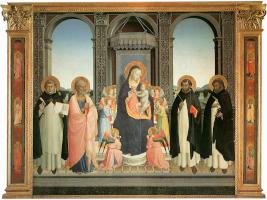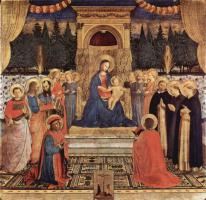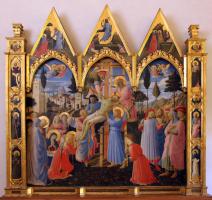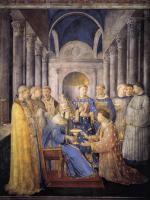Fra Angelico
Fra Angelico was both a Florentine painter and a Dominican friar. He made several trips to Rome to execute papal commissions; and he was prior of San Domenico in Fiesole from 1449 to 1452. He was known as the Blessed Angelico, and during his lifetime both his gentle, disciplined personality and his art were held in the highest esteem. The tenderness and delicate beauty of his work were ideally suited for the specific religious purpose for which it was produced.
With the help of many assistants, Fra Angelico decorated the cloister, the cells, the common rooms and the corridors of the convent of San Marco in Florence with some fifty frescoes. Of them all The Annunciation is probably the most famous. It was painted on a wall of the convent cloister, and the receding vaulted arches of the outside loggia, in which the Virgin sits, reflect the fresco’s surroundings as well as giving space and depth to its composition. Inscribed on the border of the loggia’s stone floor is a quotation in Latin from a twelfth-century hymn : ‘Hail Mother, noble resting place of all the Holy Trinity.’ Along the edge of the floor is a reminder to the friars of the convent : ‘When you come before the image of the spotless Virgin, beware lest through carelessness the Ave be left unsaid.’
 The frescoes in the convent of San Marco decorated both the communal spaces
and the nuns’ private cells, where they were designed to encourage meditation.
Fra Angelico’s experience as an illuminator shows in his thin, precise
application of paint. It was an ideal method for detailing wing feathers and
embroider, and well suited to background features.
The frescoes in the convent of San Marco decorated both the communal spaces
and the nuns’ private cells, where they were designed to encourage meditation.
Fra Angelico’s experience as an illuminator shows in his thin, precise
application of paint. It was an ideal method for detailing wing feathers and
embroider, and well suited to background features.
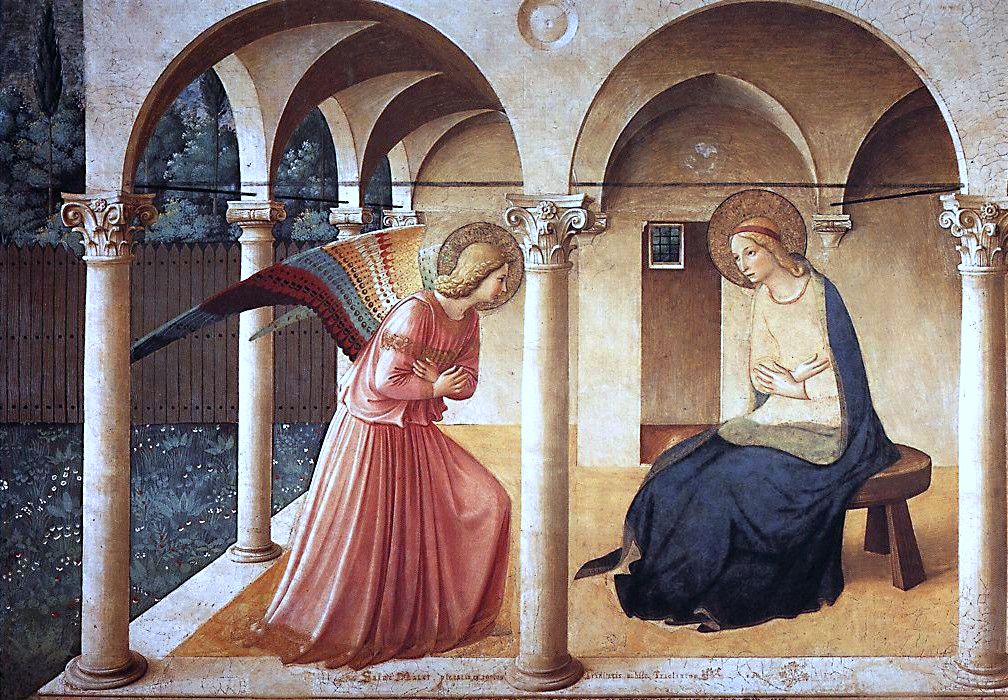 The soft pale colours and comparatively simple structure give the painting a
sparkling serenity, and a directness that is charming, if a little naive. If
Mary and the Angel were to stand up, their heads would no doubt touch the
ceiling; yet the springtime scene is convincing, and painted with great care
and attention to detail, particularly in the intricate decoration of the
Angel’s robe and the colourful patterning of his wings.
The soft pale colours and comparatively simple structure give the painting a
sparkling serenity, and a directness that is charming, if a little naive. If
Mary and the Angel were to stand up, their heads would no doubt touch the
ceiling; yet the springtime scene is convincing, and painted with great care
and attention to detail, particularly in the intricate decoration of the
Angel’s robe and the colourful patterning of his wings.
The figures have a weightlessness and stillness about them which makes them seem more spiritual. It is a painting about the communication of faith, and as the friars walked in the cloister of San Marco the event depicted must have seemed very real to them.
 Fra Angelico had an innovative approach to composition and is credited with
the invention of the Sacra Conversazione, a device which places all the
figures in a painting close to one another, as though in a conversation.
Although the Renaissance meant a strong move towards humanism, Fra Angelico’s
work maintained a firm reverence for the Christian ideal.
Fra Angelico had an innovative approach to composition and is credited with
the invention of the Sacra Conversazione, a device which places all the
figures in a painting close to one another, as though in a conversation.
Although the Renaissance meant a strong move towards humanism, Fra Angelico’s
work maintained a firm reverence for the Christian ideal.


